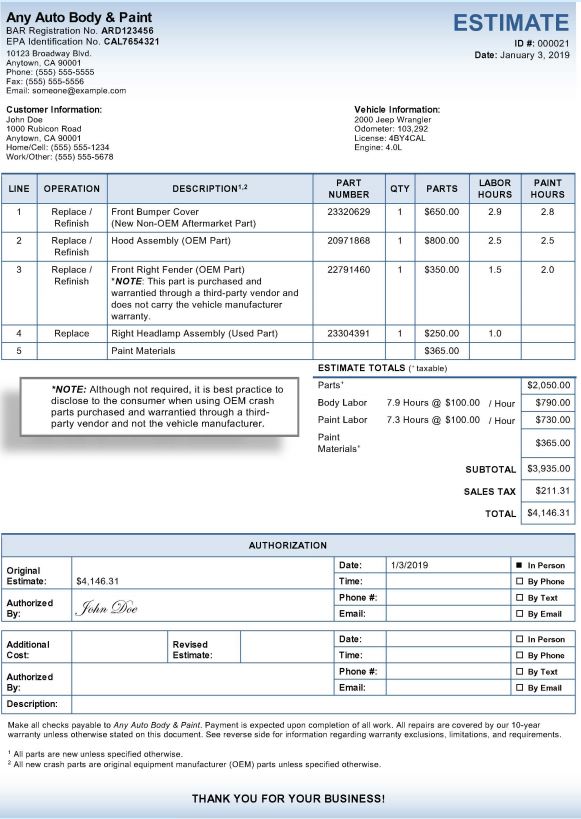Crash Part Definitions
Following the October 2018 release of a California Department of Insurance (CDI) letter (footnote #1) responding to questions raised by the California Autobody Association, the Bureau of Automotive Repair (BAR) began receiving inquiries from collision industry stakeholders regarding the definition of original equipment manufacturer (OEM) crash parts and its application to third-party vendors. This article is intended to share with automotive repair dealers (ARDs) the information BAR has provided in response to those various inquiries and ensure ARDs have a clear and consistent understanding of the laws regulating the use of crash parts in collision repairs.
OEM and non-OEM aftermarket crash parts are defined in California Code of Regulations (CCR), title 16, sections 3303(p) and 3303(q), respectively, which state:
“Original Equipment Manufacturer crash part” or “OEM crash part” means a crash part made for or by the original vehicle manufacturer that manufactured, fabricated or supplied a vehicle or a component part.
“Non-Original Equipment Manufacturer aftermarket crash part” or “non-OEM aftermarket crash part” means aftermarket crash parts not made for or by the manufacturer of the motor vehicle.
CCR section 3353(b) predicates the need for these definitions by requiring that all new crash parts listed in an estimate are considered an OEM part unless specifically identified as a non-OEM aftermarket part. There are no allowances in BAR regulations for descriptions or terminology such as “opt-OEM,” “alt-OEM,” “surplus-OEM,” “blemished-OEM,” “QRP” (quality replacement part), “LKQ” (like kind and quality), or other similar terms. Further, BAR regulates ARDs and does not have specific jurisdiction over vendors of automotive parts. It is the responsibility of each BAR-registered ARD to determine whether the new crash parts used to repair a consumer’s vehicle meet the definition of OEM or non-OEM aftermarket. Additionally, the ARD is required to provide the consumer with both an estimate and an invoice that properly describe all parts, including OEM and non-OEM aftermarket crash parts, used during the repair of the vehicle.
BAR does not have regulations addressing crash part warranties, including those sold by third-party vendors. BAR’s crash part definitions do not include a part’s newness, packaging, seller, or warranty provider. As a consumer protection agency, BAR educates ARDs on the importance of clear communication, including the consumer’s right to make an informed decision about the repairs they authorize. It is critical that ARDs understand their role in ensuring consumers are not misled. They can be held liable for any false or misleading statements that cannot be supported and are done with the intent to deceive the consumer. BAR acknowledges that some vehicle manufacturers recognize certain third-party vendors as suppliers of their OEM parts, but others may not, which underscores the importance of ARDs doing their research and not relying on a specific vendor’s representation. Below is a sample collision repair estimate from Appendix B of BAR’s recently updated Write It Write guide. The descriptions provide clear information to the consumer about whether crash parts are OEM or non-OEM aftermarket, the supplier of the parts, and warranty information.
On April 18, 2019, BAR held a workshop on proposed amendments to regulations related to auto body repair. The workshop presentation and proposed regulation text are available on BAR’s website.
Additional information to help educate ARDs on these issues—with definitions, Q&As, and various document samples—is included in BAR’s recently updated Write It Right guide, which is available on BAR’s website at www.bar.ca.gov.
Footnote #1: CDI’s letter is available at www.insurance.ca.gov.

